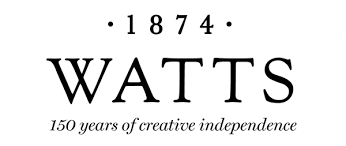This ‘money spinner’ on the side was a little too grubby for gentleman-architects unwilling to be directly associated with trade, and so the company was born as Watts and Co. While some have suggested that the name may have come from a pun ‘Watts in a name?’, the firm may also have been named after Scott’s landlord, R.R. Watts.
All three architects had been pupils of the grand old man of Victorian architecture, Sir George Gilbert Scott, and were initially steeped in his Gothic Revival aesthetic. By the 1870s, however, they had developed a new style, an eclectic mélange of Tudor, Elizabethan and 17th century neo-classical architecture, which came to be known as the ‘Queen Anne’ style.
The breadth of influences that underpinned the ‘Queen Anne’ movement also lay behind Watt’s early fabric and wallpaper designs. These drew inspiration from a variety of sources, including the geometric neo-Gothic wallpapers of Augustus Pugin, the sumptuous fabrics depicted in fifteenth-century paintings, the naturalism of William Morris, and grand late seventeenth-century damasks. Watts offered a full decoration service, including the option of a specialist painter, Mr Mole, and customers were able to buy ‘Embroidery and Textile Fabrics, such as Damasks, Silks, Velvets, Woollen and other Hangings…Wall Papers and Stained Glass, together with all the usual Articles of Household Furniture.’
Watts 1874 ... celebrating 150 years of creative independence
Lorem ipsum dolor sit amet, consectetur adipiscing elit. Mauris nec quam vel odio mollis ultricies. Suspendisse facilisis condimentum ex, at ultricies lacus sagittis ac. Etiam in nibh laoreet felis sagittis tempor a in ante. Nam elit sapien, luctus ut orci vitae, mattis euismod ipsum. In vitae pulvinar leo, a maximus.
1836
Charles Barry employs architect A.W.N Pugin to assist with the interior decoration of the new Palace of Westminster, relying heavily on him particularly in the matter of detail, fittings and furnishings.
1846
At the age of 19, G F Bodley joins the architectural practice of Sir George Gilbert Scott. Watts three founders George Fredrick Bodley, Thomas Garner and George Gilbert Scott junior all train together under Scott senior, with Bodley & Garner subsequently establishing their own architectural partnership in 1868.
1851
Probably the most influential cultural event of the 19th century, The Great Exhibition in The Crystal Palace, London, showcased manufactured products and inspired a succession of international fairs in other major world cities. Pugin’s Medieval Court led the display of ecclesiastical sculpture, metalwork and textiles, fuelling enthusiasm, including Queen Victoria’s, for Gothic architecture and furniture. A prolific designer, Pugin submitted the design for ‘Bellini’ to J G Crace for use in the interior decoration of Abney Hall, Cheshire in the same year.
1870
G F Bodley registers his first wallpaper design - ‘Bodley’. This bold design mixes a Pugin-esque geometry with naturalism.
1874
Bodley, Garner & Scott founded Watts & Co. In addition to continuing as architects, at Watts & Co our founders will be named as ‘Art Directors and advising architects’ producing their own decorative art with an artistic freedom for both the church & domestic projects. This ‘on the side’ enterprise created a design house offering a full decoration service for architects to enhance all aspects of their buildings, including the interiors.
1879
Watts takes on the lease of 30 Baker Street (until 1947), a premises that becomes known for its dazzling window display and otherworldly atmosphere. A place of draughtsmanship, elaborate detailing, seamstresses, embroiderers and embellishment. Bound together with the rich histories of the Gothic Revival and the Aesthetic Movement, Watts rapidly established itself as providers of fabrics and furnishings of the finest quality and best possible taste.
1884
From its beginnings, Watts & Co designs were sold commercially and as such were used extensively by the leading architects and designers of the day. This, of course, included Bodley, Garner and Scott whose own architectural careers flourished during this period. In 1884 Garner is engaged as lead architect with Bodley, by Lord & Lady Windsor to design and build Hewell Grange in Worcestershire (Grade I listed). Hewell Grange is thought to be one of their major country house commissions and was completed in 1891.
1886
Bodley and Garner restore Ham House in Surrey for the 9th Earl of Dysart. Watts wallcovering including the Ravenna, Genoese and Pear were used. Bodley’s bold Pear design is used to striking effect on the walls of the Great Hall.
1902
The 4th Earl of Powis, engages Bodley to undertake substantial alterations to Powis Castle in what was the last major phase in the building’s architectural history. H. C. Brewer’s watercolour paintings capture the interiors which celebrate Bodley’s complete decorative scheme including products supplied by Watts & Co. Here, the Pear is woven as a green cut silk velvet, this large-scale design being particularly suited to stately chairs.
1939
Elizabeth was a society beauty with a stage and film career. Elizabeth also known as Betty, was first an actress having won a scholarship to RADA in 1934 . She acted on the stage and then in film, although never taking up her invitation to Hollywood because she felt she looked too much like fellow British actress Vivien Leigh! In 1939, Elizabeth married Graham Hoare. She worked for BBC Drama during the Second World War before joining Watts in 1948.
1948
Elizabeth Hoare joins Watts, becoming Managing Director in 1956 until her death in 2001. Under Mrs Hoare’s leadership Watts weathers post-war austerity and embarks on its own revival. Her charm, energy and intelligence, together with loyal ecclesiastical clients ensuring the company’s survival.
1953
With a keen eye for talent, designer Keith Murray joins Watts in 1951 (until 1961). A ‘very sparky, modern kind of chap’ who brought innovation and lively artistic interpretation. Watts’ close association with royal occasions date back to vestments for the jubilee celebrations for Queen Victoria in 1887 and 1897. Since the coronation of Edward VII in 1902, Watts have produced designs for every coronation. Especially striking were the copes Keith Murray designed for the coronation of Queen Elizabeth II at Westminster Abbey in 1953. A bold design of elongated lions and unicorns with jewelled eyes that embraced modernism, adapting its minimalism to tradition designs. A blue silk damask embroidered altar frontal in Bodley’s ‘Gothic’ design was presented to Westminster Abbey by the Queen to mark her coronation.
1975
Six wallpaper designs by Pugin were re-discovered. Opportunistically given to Mrs Hoare, these papers that were part of the portefolio of designs commissione for the Palace of Westminster were added to the Watts collection.
1987
With Fiona Flint as Creative Director, Watts 1874 is set up, allowing the secular and ecclesiastical wings of the company to split and operate independently. The Hoar Cross Collection is launched as Watts first hand printed wallpaper pattern book made up of ten designs by G F Bodley & Pugin. At this point, all the papers in the pattern book were converted from handblock production to screen print.
1991
Watts 1874 is one first brands to sign up to globally recognised interior design event, Decorex.
1992
Mrs Hoare amassed a fine collection of Victorian textiles and embroidery during the latter twentieth century, her devotion to which delightedly culminated in the ground-breaking establishment of the Elizabeth Hoare Gallery of Embroidery at Liverpool Anglican Cathedral (a triumphant Gothic cathedral fittingly designed by Elizabeth’s uncle Giles Gilbert Scot with assistance from Bodley).
1995
Watts 1874 moves to Chelsea Harbour Design Centre. Reminicent of the first Watts premises in Baker Street, the current showroom proveds a sophisticated setting that exudes the same creativity, rich decorative period pattern and innovation. Digital, screen and handblocked wallcoverings, exquisite silks, figured velvets and beautifully embellishing passementerie offer a dynamic design experience.
2011
Following the death of Mrs Hoare in 2002, her granddaughter Marie Severine de Caraman Chimay (MS) joined Watts 1874 as current director. Proudly a family firm that continues to be run by the fifth generation of the founders’ descendants. Together with Fiona Flint, the Watts design house remains an enduring resource for conservation and restoration, with many bespoke projects including collaborations with the prestigious Castle Howard in 2023 showcase expertise and celebrate grand interiors.
2024
As Watts celebrates this ’special birthday’, legacy remains at the heart of everything. The boldness of our archive excites with new collections, exhibitions and events inspire, and we continue to work globally in different sectors, entertainment, hospitality, residential and the historic house. Pivotal to this milestone year is the continued collaboration with Cité Internationale de la Tapesserie, Aubusson. The opportunity to work with the Museum in Aubusson is a gift that for years to come will be seen as one of those significant associations in the history of any company that seriously influences their future

Lorem ipsum dolor sit amet, consectetur adipiscing elit. Mauris nec quam vel odio mollis ultricies. Suspendisse facilisis condimentum ex, at ultricies lacus sagittis ac. Etiam in nibh laoreet felis sagittis tempor a in ante. Nam elit sapien, luctus ut orci vitae, mattis euismod ipsum. In vitae pulvinar leo, a maximus.





















